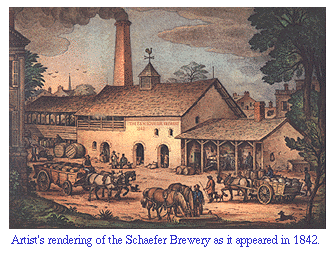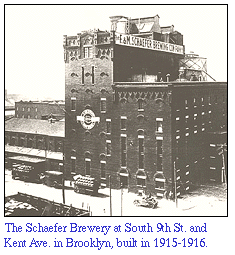[an error occurred while processing this directive]
Antique Beer Photos:

Dozens of prints available in a variety of sizes up to 40x50. |  |
|
|
By permission of the author, the following is reproduced from Will Anderson's fine book, Breweries of Brooklyn, published in 1976.
THE F. & M. SCHAEFER BREWING COMPANY
Longest operating brewery in New York City, last operating brewery in New York City [as of 1976], and America's oldest lager beer brewing company -- these honors, plus many others, all belong to The F. & M. Schaefer Brewing Co.
"F. & M.", as most breweriana buffs know, stands for Frederick and Maximilian, the brothers who founded Schaefer. Frederick Schaefer, a native of Wetzlar, Prussia, Germany, emigrated to the U.S. in 1838. When he arrived in New York City on October 23rd he was 21 years old and had exactly $1.00 to his name. There is some doubt as to whether or not he had been a practicing brewer in Germany, but there is no doubt that he was soon a practicing brewer in his adopted city. Within two weeks of his landing, Frederick took a job with Sebastian Sommers, who operated a small brewhouse on Broadway, between 18th and 19th Streets. Frederick obviously enjoyed both his job and life in America, and the next year his younger brother, Maximilian, decided to make the arduous trip across the Atlantic also. He arrived in June of 1839 and brought with him a formula for lager, a type of beer popular in Germany but unheard of in the United States. The brothers dreamed, and planned, and saved - and in the late summer of 1842 they were able to buy the small brewery from Sommers. The official, and historic, starting date was September, 1842.

Sommers' former facility was a start, but that's all it was, as it was much too small. New York beer drinkers immediately took a liking to "the different beer" the brothers brewed, and in 1845 Frederick and Maximilian developed a new plant several blocks away, on 7th Avenue, between 16th and 17th Streets (7th Avenue and 17th Street is today, of course, well known as the home of Barney's, the giant men's clothing store). This, too, proved to be just a temporary move; the plant was almost immediately inadequate to meet demands and the brothers wisely decided to build yet
another new plant, and to locate it in an area where they could expand as needed. Their search took them to what were then the "wilds" of uptown Manhattan. In 1849 the brewery, lock, stock and many barrels, was moved to Fourth Ave. (now Park Avenue) and 51st Street. Here, just north of Grand Central Station, the Schaefers brewed for the next 67 years, ever-expanding their plant. The only problem was that the brothers were not the only ones to locate "uptown." The area in the 40's, 50's and 60's grew rapidly all during the last half of the 19th century, and especially after the opening of the original Grand Central Terminal in 1871. Frederick and Maximilian had wisely purchased numerous lots between 50th and 52nd Streets, and by the time they passed away (Frederick in 1897 and Maximilian in 1904) the brewery was, literally, sitting atop a small fortune. Maximilian's son, Rudolph J. Schaefer, fully realized this when he assumed the Presidency of the brewery in 1912. In that same year Rudolph purchased the 50% of the company owned by his uncle Frederick's heirs. He thus had complete control of the brewery, and one of the first matters he turned to was the suitable location for a new, and presumably everlasting, plant. In 1914, in anticipation of its move, Schaefer sold part of the Park Ave. site to St. Bartholomew's Church. This sale, for a reputed $1,500,000, forced Rudolph to intensify his search for a new location. Finally, in June of 1915, it was announced that the brewery had decided on a large tract in Brooklyn, directly on the East River and bounded by Kent Avenue and South 9th and 10th Streets. Here, starting in 1915, Rudolph constructed the very best in pre-Prohibition breweries. The move across the river to their ultra-new and modern plant was made in 1916, just four years before the Volstead Act crimped the sails (and sales!) of all United States breweries, new or old alike.
 While it must have seemed a real shame to brew "near beer" in his spanking new plant, Rudolph Schaefer obviously felt that near beer was better than no beer at all; consequently, the brewery remained in operation all during Prohibition, producing mostly near beer but also manufacturing dyes and artificial ice. While it must have seemed a real shame to brew "near beer" in his spanking new plant, Rudolph Schaefer obviously felt that near beer was better than no beer at all; consequently, the brewery remained in operation all during Prohibition, producing mostly near beer but also manufacturing dyes and artificial ice.
In 1923 Rudolph J. Schaefer passed away at the relatively young age of 60. Control of the company thus passed to his two sons, Frederick M.E. Schaefer and Rudolph J. Schaefer, Jr. Frederick guided the brewery for several years but was troubled by poor health, therefore, in 1927, only a
few years after his graduation from Princeton University, Rudolph Jr. was elected President. Although he was by far the youngest brewery President in the United States, Rudy, Jr. provided excellent leadership. Several months before that magic Repeal date of April 7, 1933, when 3.2% beer became legalized, he beat most of his New York City competitors to the punch by launching an extensive advertising campaign, centered around the theme that "Our hand has never lost its skill." Rudy, Jr. also personally outlined and designed many of the new buildings added to the brewery in expansion programs in the 1930's and early 1940's.
In 1938 Schaefer joined that exclusive group of brewers that sold 1,000,000 barrels in a year, and the 2,000,000 mark was passed in 1944, two years after the company celebrated its 100th birthday in 1842. Sales continued strong throughout the 1940's and, to increase capacity, Schaefer purchased the former Beverwyck Brewery Co. in Albany, New York in 1950. They remained a two-plant company until 1961 when, with an eye toward expanding into large areas of the mid-west, Rudy Schaefer purchased the Standard Brewing Company, of Cleveland, Ohio. This, however, did not turn out to be a wise move; Schaefer beer just didn't seem to catch on in Ohio, and within two years Schaefer sold the plant to C. Schmidt and Sons, which used it as their midwestern brewing arm. In what almost seems like musical breweries, however, Schaefer added a plant in Baltimore in the same year, 1963, that it disposed of its Cleveland facility. Ironically, Schaefer purchased the Baltimore plant from Theo. Hamm, a large St. Paul, Minn. brewer that had been attemping, with little success, to move into the east coast. The grass may always seem greener in the other brewer's territory, but it certainly wasn't so for both Schaefer and Hamm's in the early 1960's!
Schaefer's most dramatic move with respect to plants was the decision, in 1971, to build a brand new, ultra-modern brewery just outside of Allentown, Pa. Realizing that all three of its plants at the time, Brooklyn, Albany, and Baltimore, were old and inefficient, Schaefer management decided it had to go the route being taken by Pabst, Schlitz, Anheuser-Busch and Miller - build a brand new and thoroughly modernized brewery rather than continue to try to upgrade old facilities. To construct a new brewery is extremely expensive, of course, but when it was opened in 1972 Schaefer could be justifiably proud - their Lehigh Valley plant was one of the most modern and efficient breweries in the world!
What does a company do, however, when it has one ultra-modern plant and three that appear very dated by comparison? The question is really rhetorical, of course; strive to add to the modern plant while phasing
out the less efficient facilities. And that's exactly what Schaefer did. The Albany plant was shut down almost immediately, on December 31st of 1972. In 1974 the Lehigh Valley plant was expanded from its original
1,100,000 barrels-per-year capacity to 2,500,000 and then, in 1975, it was decided to expand again - to 5,000,000 barrels plus. By 1975, therefore, it was obvious that one of the two less efficient plants should and would be closed, the only questions remaining was which plant, Brooklyn or Baltimore, and when. Both questions were answered on January 22, 1976 when Robert W. Lear, Chairman and Chief Executive Officer of The F. & M. Schaefer Corp., announced the closing of the Brooklyn plant. This announcement, only one week after Rheingold disclosed its plans to also shut down in Brooklyn, left Brooklyn and New York City without a single producing brewery. While both Frederick and Maximilian Schaefer, if they were alive today, would undoubtedly be proud of Schaefer's history and many years of brewing, and would certainly be impressed with the modern brewing techniques reflected in the Lehigh Valley plant, I suspect they'd feel very badly about the closing of the company's brewery in New York City, the city that's had a love affair with Schaefer lager for over 134 years.
[Webmaster's Note: In 1981, the F. & M. Schaefer Brewing Company was purchased by the Stroh Brewery Company which continues to sell Schaefer Beer today. However, with Stroh's pending sale to the Pabst Brewing Company (to be completed by the end of 1999), the future of the venerable Schaefer label is uncertain.]
|